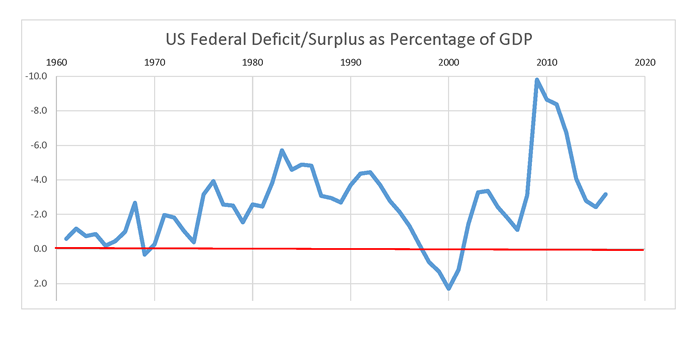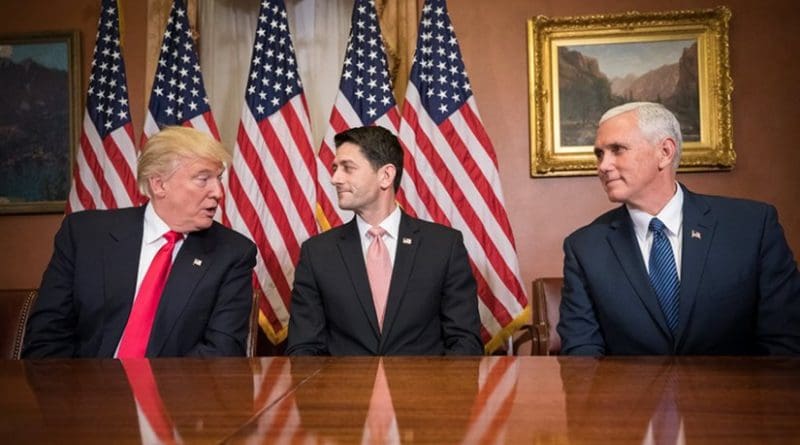Day Of Reckoning Looms For Republicans, Long Opposed To Raising US Debt Ceiling – Analysis
The US debt approaches $20 trillion and the Republican-controlled US Congress must agree to lift debt ceiling to avoid default.
By David Dapice*
The United States has reached its self-imposed statutory debt limit and the US Treasury must start taking “extraordinary measures,” including putting a stop to issuing some securities.
Last October, US Congress suspended the US federal debt limit of $18.4 trillion until March 15, 2017. The old debt limit goes into effect once again – even though the actual debt now approaches $20 trillion. The US Treasury could buy a few months by shifting around various accounts. But by September, unless the Republican Congress suspends the debt limit again or increases the ceiling, the United States will no longer pay all of its debts.
The debt is now the responsibility of Republicans who resisted deficit spending when Barack Obama was president. The Republicans hold a solid majority in the House of Representatives and a lean majority in the Senate.
The Republican Congress and President Donald Trump hope to cut income and business taxes, increase defense spending and begin building an expensive southern border wall and invest in large infrastructure investments. But the deficit will rise and add to current debt levels. Interest rates are likely to increase several times this year, adding to interest expenses and pushing the 2017 deficit higher. Cuts in welfare and other discretionary spending or a possible border tax may lessen the pressures, but cannot offset them. Despite unclear plans, various groups, including conservative think tanks, have all concurred that the tax plans would add from $2.8 trillion to $10 trillion in debt over the next decade, even if growth were plausibly higher.
If all Republicans voted together, they could easily pass a debt limit increase without the Democrats.
But the party’s deficit hawks, especially the Tea Party Caucus from 2010 or the Freedom Caucus since 2014, have taken uncompromising stands against increased deficits. As J. Ragusa and A. Gaspar noted in Political Research Quarterly, 2016: “Although the Tea Party is not a party in the classic sense of the word, research has shown that members of the Tea Party Caucus vote like a third party in Congress.” Voters may not have forgotten why they sent deficit hawks to Congress and follow the debt limit talks closely.
If conservatives maintain their anti-deficit stance, they could strengthen the Democrats’ ability to block tax cuts and increases in defense spending.
Here are some possible scenarios:
- Conservative caucuses continue to resist deficit spending and force mainstream Republicans to cut a deal with at least some Democrats. In the House, 218 votes are needed to pass a debt limit increase, so the 190 Republican members not affiliated with either the Tea Party or the Freedom Caucus may need nearly 30 Democrat votes in the House.
- Conservative caucuses and mainstream Republicans agree on some combination of tax cuts and spending increases, with some offsetting cuts, acceptable to Trump. This option suggests reluctance to raise deficits very much.
- Conservative caucuses fold, and the US spending spree with tax cuts continues. Deficits rise sharply.
- Conservative caucuses hold fast, but the remaining Republicans fail to attract enough Democrat votes to raise the debt ceiling. The country cannot pay for all of its spending, and decisions must be made by Trump, Treasury Secretary Steven Mnuchin and others about who gets paid first.
Remember that the existing debt ceiling has already been breached. The choices are to eliminate the debt ceiling altogether, suspend it again for a period of time, or raise it and go through the same round of negotiation again later. In addition, the aging US population is already pushing deficits higher – up to about 5 percent of GDP in 10 years under existing laws, according to the nonpartisan Congressional Budget Office.
Adding net spending or tax cuts would push these already worrisome deficits even higher, possibly leading to much higher interest rates and debt financing costs. Most economists do not expect real GDP growth can exceed 3 percent a year for any sustained period, so even “dynamic scoring” – allowing for the expansionary impact of loose fiscal policy – does not solve the problem. This is crunch time. Either the deficit hawks file their claws or a centrist compromise is required if the bills of Uncle Sam are to be paid.
Democrats may be considering what to demand if they do get a chance to provide crucial votes. Do they insist on keeping Medicaid expansion intact, as many Republican governors also want? Do they push for a carbon tax with rebates, and so offset much of the deregulation meant to support greater fossil fuel production? This has been suggested by conservative economists worried about climate change. Do they insist on minimum average tax rates for upper-income groups, the so-called “Buffet Rule” so that payroll taxes like Social Security and Medicare plus income taxes are no lower for the rich?
The economics and politics are complicated, and the Democrats may be no more united than the Republicans as many regions and special interests have a range of priorities.
Likewise, it will not be easy for the Republicans to reach agreement and bypass any need to reach across the aisle. The deficit hawks bitterly opposed small incremental spending of high priority by former President Obama without offsets – even $1.8 billion for Zika research and control was defeated. Money had to be transferred from Ebola budgets to gather a fraction of what was requested to deal with a potentially severe public health problem. If Republican legislators give the go-ahead for an unproductive southern wall costing billions or needed infrastructure that they opposed when Obama was president or tax cuts favoring upper-income groups that blow up the deficit, they will have some explaining to do to voters although wealthy donors may accept deficits as the price of tax cuts.

Mainstream Republicans have had less trouble fighting deficits when the spending involved Democrat priorities while they tend to allow deficits for tax cuts and Republican priorities while promising growth and trickle-down benefits. Former President George W. Bush added $3 trillion in debt during his eight years by cutting taxes while waging wars, approving a huge bank bailout and pushing through an expensive drug plan for the elderly. Bush had inherited a budget surplus from his predecessor, Bill Clinton, but left Obama with a huge deficit, nearly 10 percent of GDP, in his first year.
So far, Trump does not appear to be a deficit hawk, although some members of his cabinet may be more fiscally conservative. Even so, it’s all but impossible to combine his promised extension of existing pension and health benefits for the elderly and veterans with substantial tax cuts and large increases in other spending. There are simply not enough plausible offsets from discretionary spending, already hit hard by past cuts.
Republicans are completely accountable, and it’s unlikely that they wish to shut down the government or block the government from paying bills. They know lifting the debt ceiling, combined with more spending and tax cuts, is likely to raise interest rates and the cost of financing the nation’s $20 trillion in government debt.
Some deal will likely emerge, but its shape and supporters are not easy to predict. The Republican Party has been a party of opposition, adopting scorched-earth policies against even vital and sensible spending, whether Zika research or repair of crumbling bridges. We will learn whether insurgents can govern. Government needs funds to operate and if Republicans lack the will, flexibility or imagination to find a workable compromise – chaos will ensue.
*David Dapice is the economist of the Vietnam Program at Harvard University’s Kennedy School of Government.

